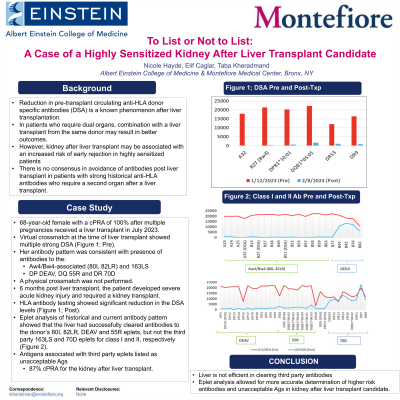Back

To List or Not to List; A Case of A Highly Sensitized Kidney After Liver Transplant Candidate
(P303) To list or not to list; A case of a highly sensitized kidney after liver transplant candidate
Location: Platinum Ballroom

Poster Presenter(s)
Background: Reduction in pre-transplant circulating anti-HLA donor specific antibodies (DSA) is a known phenomenon after liver transplantation. In patients who require dual organs, combination with a liver transplant may result in better outcomes. However, there is no consensus in avoidance of antibodies post liver transplant in patients with strong historical anti-HLA antibodies who require a second organ after a liver transplant. Case Study: A 68-year-old female with a history of cirrhosis with a cPRA of 100% after multiple pregnancies received a liver transplant in July 2023. Virtual crossmatch at the time of liver transplant showed multiple strong DSA (Figure 1; Pre). Her antibody pattern was consistent with presence of antibodies to the Aw4/Bw4-associated (80I, 82LR) and 163LS eplets for class I and DP DEAV, DQ 55R and DR 70D eplet for class II. A physical crossmatch was not performed. At six months post liver transplant, the patient developed severe Acute Kidney Injury and required listing for a kidney transplant. HLA antibody testing showed significant reduction in the DSA levels (Figure 1). To determine which historically strong antigens should be avoided, eplet analysis of historical and current antibody pattern showed that the liver had successfully cleared antibodies to the donor’s 80I, 82LR, DEAV and 55R eplets, but not the third party 163LS and 70D eplets for class I and II, respectively (Figure 2). As such, we decided to list antigens associate with these eplets as unacceptable which resulted in 87% cPRA for the kidney after liver transplant.
Conclusion: Although liver transplant is associated with a clearance of anti-HLA antibodies, kidney after liver transplant may be associated with an increased risk of early rejection in highly sensitized patients. Liver’s role in clearance of donor-specific versus third party antibody is incolclusive due to lack of granular eplet analysis data in the litereture. In the current case, eplet analysis allowed for more accurate determination of which antigens may be higher risk.
Conclusion: Although liver transplant is associated with a clearance of anti-HLA antibodies, kidney after liver transplant may be associated with an increased risk of early rejection in highly sensitized patients. Liver’s role in clearance of donor-specific versus third party antibody is incolclusive due to lack of granular eplet analysis data in the litereture. In the current case, eplet analysis allowed for more accurate determination of which antigens may be higher risk.

